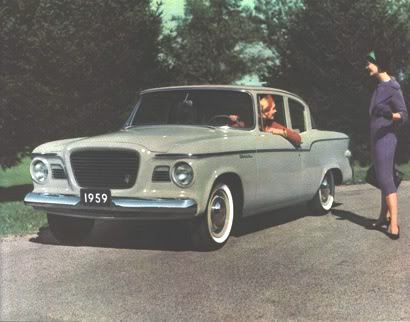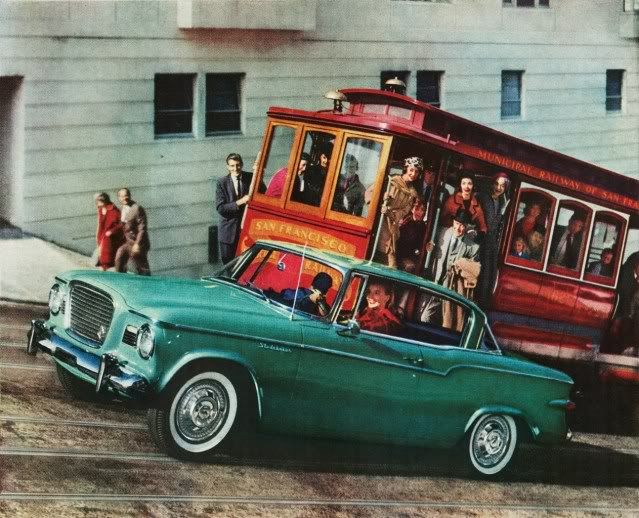At first sight, there is not much to link a 1959 Studebaker to a 1958. The venerable company has given up the full-size segment and decided to concentrate on compact cars. With no sufficient budget to develop a new automobile, miracles have been performed by designer Duncan MacRae to create new, short front- and rear-ends to graft to the central cell of the previous models. Not only this has allowed Studebaker to save vital money, but gives a surprisingly large passenger compartment for a car of its size. Better yet, this ingenious patchwork has had no negative consequence on its overall look. Economical and practical, yet thrifty, the Lark sells well to a part of the public which has grown wary of the nonsensical Detroit products: Studebaker records a benefit for the first time in six years.
Studebaker Lark DeLuxe
The new Lark DeLuxe is a very plain car, sporting less chrome on its front end than virtually any other vehicle built in Detroit. Though available in theory as either “Lark VI” or ”Lark VIII” depending on the engine fitted, virtually no eight-cylinder car is made in this series.

● Introduction: 1952 as the original full-size model, fall 1958 as the shortened and heavily reworked compact. Construction: body on separate chassis. Engine: water-cooled inline six, 2.8-litre, 90 hp, mounted at the front (Lark VI). Optional engine: V-8, 4.2-litre, 180 hp (Lark VIII). Lower compression ratios (and hence lower outputs) could be ordered for exported cars in order to cope with gasoline with poorer octane rates. Transmission: to the rear wheels through a three-speed manual gearbox. Three-speed automatic gearbox optional. Suspension: independent at the front, rigid axle at the rear. Brakes: hydraulic, to drums on all four wheels. Servo optional. Length: 445 cm (sedans), 469 cm (station wagon). Top speed: n/a. Range: two-door sedan, four-door sedan, two-door station wagon.
Studebaker Lark Regal
The Lark Regal adds more chrome around the headlights and offers a padded instrument panel. As the DeLuxe, it is split into two series, “Lark VI” or “Lark VIII” depending on the number of cylinders of their engine.

● Introduction: 1952 as the original full-size model, fall 1958 as the shortened and heavily reworked compact. Construction: body on separate chassis. Engine: water-cooled inline six, 2.8-litre, 90 hp, mounted at the front (Lark VI). Optional engine: V-8, 4.2-litre, 180 hp (Lark VIII). Lower compression ratios (and hence lower outputs) could be ordered for exported cars in order to cope with gasoline with poorer octane rates. Transmission: to the rear wheels through a three-speed manual gearbox. Three-speed automatic gearbox optional. Suspension: independent at the front, rigid axle at the rear. Brakes: hydraulic, to drums on all four wheels. Servo optional. Length: 445 cm (sedan and hardtcop coupe), 469 cm (station wagon). Top speed: n/a. Range: four-door sedan, two-door hardtop coupe, two-door station wagon.
Studebaker Lark Econ-O-Miler
In addition to these models accessible to the general public, Studebaker also proposes a variant of the new Lark specially intended for fleets, mostly taxicab operators. It is built on the longer chassis of the station wagon, but exclusively available as a four-door sedan.

● Introduction: 1952 as the original full-size model, fall 1958 as the shortened and heavily reworked compact. Construction: body on separate chassis. Engine: water-cooled inline six, 2.8-litre, 90 hp, mounted at the front (Lark VI). Optional engine: V-8, 4.2-litre, 180 hp (Lark VIII). Transmission: to the rear wheels through a three-speed manual gearbox. Suspension: independent at the front, rigid axle at the rear. Brakes: hydraulic, to drums on all four wheels. Servo optional. Length: 455 cm. Top speed: n/a. Range: four-door sedan.
Any mistake you’ve just spotted? A detail to add? A suggestion? Don’t hesitate to leave a comment!
Click to jump to another model year of the same car: 1959 – 1960 – 1961 – 1962 – 1963 – 1964 – 1965 – 1966
Click here to return to a list of all Studebaker vehicles presented on this blog.
Click here to return to this blog’s initial post, featuring a list of all brands already presented.
Studebaker Lark DeLuxe
The new Lark DeLuxe is a very plain car, sporting less chrome on its front end than virtually any other vehicle built in Detroit. Though available in theory as either “Lark VI” or ”Lark VIII” depending on the engine fitted, virtually no eight-cylinder car is made in this series.

● Introduction: 1952 as the original full-size model, fall 1958 as the shortened and heavily reworked compact. Construction: body on separate chassis. Engine: water-cooled inline six, 2.8-litre, 90 hp, mounted at the front (Lark VI). Optional engine: V-8, 4.2-litre, 180 hp (Lark VIII). Lower compression ratios (and hence lower outputs) could be ordered for exported cars in order to cope with gasoline with poorer octane rates. Transmission: to the rear wheels through a three-speed manual gearbox. Three-speed automatic gearbox optional. Suspension: independent at the front, rigid axle at the rear. Brakes: hydraulic, to drums on all four wheels. Servo optional. Length: 445 cm (sedans), 469 cm (station wagon). Top speed: n/a. Range: two-door sedan, four-door sedan, two-door station wagon.
Studebaker Lark Regal
The Lark Regal adds more chrome around the headlights and offers a padded instrument panel. As the DeLuxe, it is split into two series, “Lark VI” or “Lark VIII” depending on the number of cylinders of their engine.

● Introduction: 1952 as the original full-size model, fall 1958 as the shortened and heavily reworked compact. Construction: body on separate chassis. Engine: water-cooled inline six, 2.8-litre, 90 hp, mounted at the front (Lark VI). Optional engine: V-8, 4.2-litre, 180 hp (Lark VIII). Lower compression ratios (and hence lower outputs) could be ordered for exported cars in order to cope with gasoline with poorer octane rates. Transmission: to the rear wheels through a three-speed manual gearbox. Three-speed automatic gearbox optional. Suspension: independent at the front, rigid axle at the rear. Brakes: hydraulic, to drums on all four wheels. Servo optional. Length: 445 cm (sedan and hardtcop coupe), 469 cm (station wagon). Top speed: n/a. Range: four-door sedan, two-door hardtop coupe, two-door station wagon.
Studebaker Lark Econ-O-Miler
In addition to these models accessible to the general public, Studebaker also proposes a variant of the new Lark specially intended for fleets, mostly taxicab operators. It is built on the longer chassis of the station wagon, but exclusively available as a four-door sedan.

● Introduction: 1952 as the original full-size model, fall 1958 as the shortened and heavily reworked compact. Construction: body on separate chassis. Engine: water-cooled inline six, 2.8-litre, 90 hp, mounted at the front (Lark VI). Optional engine: V-8, 4.2-litre, 180 hp (Lark VIII). Transmission: to the rear wheels through a three-speed manual gearbox. Suspension: independent at the front, rigid axle at the rear. Brakes: hydraulic, to drums on all four wheels. Servo optional. Length: 455 cm. Top speed: n/a. Range: four-door sedan.
Any mistake you’ve just spotted? A detail to add? A suggestion? Don’t hesitate to leave a comment!
Click to jump to another model year of the same car: 1959 – 1960 – 1961 – 1962 – 1963 – 1964 – 1965 – 1966
Click here to return to a list of all Studebaker vehicles presented on this blog.
Click here to return to this blog’s initial post, featuring a list of all brands already presented.
No comments:
Post a Comment